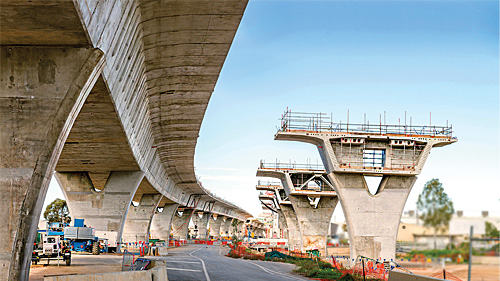Front Line: Infrastructure Investment Faces Hurdles
Projects funded by the infrastructure bill are projected to create nearly a million jobs — but filling those jobs may present a challenge.
Q4 2021

There are still major questions regarding the bill’s impact, according to Joe Kane, a fellow at the Brookings Institution who focuses on infrastructure. According to a report by S&P Global, the $1.2 trillion Infrastructure Investment & Jobs Act (IIJA) would create close to one million new jobs over the next decade, in sectors like construction, engineering, and accounting.
If it becomes law, the bipartisan, Senate-approved infrastructure bill will also increase per capita personal income in 2030 by about $100 per person, or roughly 10.5 percent, according to the S&P study. With the increase in wage-earning, households are projected to spend an additional $677 billion over the period.
The bill could also boost productivity by 2.1 percent on an annual basis over the next eight years, adding about $1.4 trillion to the economy over that period, according to S&P Global.
Where Will the Workers Come From?
But, ensuring there are enough trained, qualified workers to fill positions created by the legislation is a major issue, with Covid-19, the graying of America, and other trends impacting workforce numbers, Kane says. “There was hope among many that there would be more workforce development funding in the bill, but there is not very much.” He’s seen estimates of the number of jobs that the new infrastructure funding would create ranging from 650,000 to one million, in construction and manufacturing. It would not only have short-term impact, but also “cause a ripple effect in the decades to come, when you think of all types of workers who are involved in managing these facilities.”
Under the proposed bill, inter-agency working groups would be formed among agencies like Transportation, Energy, and the EPA, to measure what the projected workforce demands would be, Kane says. The digital equity components of the bill touch on training for some of the digital literacy and digital skills that would be needed by some workers. “There is a lot of language about ‘we need to do this,’ but there aren’t really dollar signs attached,” he says.
Under the proposed bill, inter-agency working groups would be formed among agencies like Transportation, Energy, and the EPA. Kane notes that currently, in the infrastructure sector, there isn’t much of a shortage of construction workers. As of August, construction unemployment was estimated at 4.6 percent compared to climbing to nearly 25 percent during the 2008–2009 recession.
But the shortage of workers entering the skilled trades continues, Kane says, in occupations like water treatment plant operator, train operators, machinists, and technicians. The shortage is not only due to a surge in retirements, but also the lack of a pipeline of new talent. “There are not as many younger workers coming into these sectors,” he says.
Retraining of workers let go from the hospitality sector could potentially help fill those positions, Kane points out. “When we think of those jobs, it’s not just hardhats; it’s also management, finance, and administration positions…Employers have always played a central role in job training. Whatever funding comes from the federal government hopefully can be used to build the capacity of employers at the state and local level to do some of that training.”
Kane believes there is enough political momentum to pass the bill. “Both Democrats and Republicans recognize this is a huge, shared win for the both sides of the aisle and the country.” But if it is somehow tied to the larger budget reconciliation package, which is more “sticky,” that could slow things down. “The timeline matters,” he notes. “The midterms are not far away, and the political runway is not infinite. They need to strike while the iron is hot. If they don’t, this could get delayed even more or may not happen at all.”
Project Announcements
Momentous Expands Summit County, Utah, Operations
12/21/2025
Stryker Expands Salt Lake County, Utah, Operations
12/21/2025
Portal Space Systems Expands Bothell, Washington, Operations
12/21/2025
TerraForge Biocarbon Solutions Plans Magnolia, Mississippi, Operations
12/20/2025
Coastal Ready Mix Plans Conway, South Carolina, Production Operations
12/20/2025
PRET Advanced Materials Expands Johnsonville, South Carolina, Manufacturing Operations
12/19/2025
Most Read
-
The Workforce Bottleneck in America’s Manufacturing Revival
Q4 2025
-
Rethinking Local Governments Through Consolidation and Choice
Q3 2025
-
Lead with Facts, Land the Deal
Q3 2025
-
Investors Seek Shelter in Food-Focused Real Estate
Q3 2025
-
Tariff Shockwaves Hit the Industrial Sector
Q4 2025
-
America’s Aerospace Reboot
Q3 2025
-
The Permit Puzzle and the Path to Groundbreaking
Q3 2025


